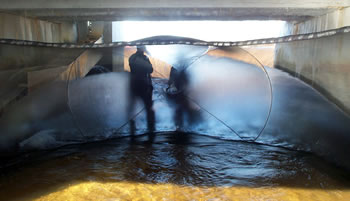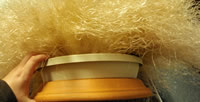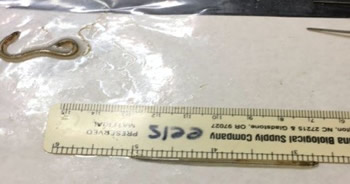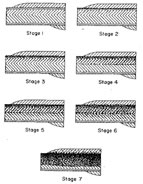  |
A Day With Glass Eels |
|
by Deanna Gambino, Hourly Fisheries Technician
Bureau of Marine Fisheries
November 29, 2017
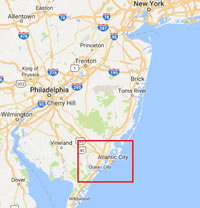 Figure 1
Figure 1 |
Finally, it was time for my first day in the field. Before heading out, we checked that the van had all the necessary gear - waders, dip net, thermometer, meter stick, buckets, tote, brush and ropes. Since a subsample of the collected glass eels (baby American Eels) get brought back to the lab each day, those eels must be taken and released back into the field the next day. I retrieved the previous day's eels from the wet lab, set them up with an aerator to keep oxygen flowing through the water, and put them in the van to come with us out in the field.
When we pulled up to the first site, located in a tributary of the Great Egg Harbor Bay (Figure 1), everyone changed into their waders. I was told to release the eels from yesterday in the pond above the dam, so that they can continue their swim upstream. Then all the equipment was carried under a bridge where a fyke net (a stationary net used to sample in shallow waters) had been set next to a fish ladder.
|
|
|
I learned that the fyke net stays in the water for at least six weeks in the winter, and that the net is emptied every day. The open edges guide the fish into the collection column or the cod end (Figure 2).
Using the brush, I cleaned the fyke net of any algae so that the water can continually flow through the net. The water temperature and water level were noted using the thermometer and the meter stick. To tend the net, we used rope to tie the cod end of the fyke net out of the water. Now we could safely disconnect all other ropes from the cod end and empty the catch from the net into a tote.
It is important to make sure the net is actually empty; glass eels are tiny and good at getting stuck and hiding in the net. Thousands of eels were caught! Any of the catch that is not an American Eel is considered bycatch. The bycatch was identified, counted and released. The eels were placed in a bucket while the net was reset. Once the net was set, all our gear was collected, along with the glass eels from the fyke net, and we started toward the van.
|
At the van, the total weight for all the glass eels was determined and logged. For the subsample, sixty glass eels were counted out, placed in a bucket of water with an aerator running, and put in the van to be taken back to the lab. Before heading back to the lab, we still had to go to our second site, which is located in a tributary of Great Bay (Figure 1).
|
At the second site, there was a collector as opposed to a fyke net (Figure 3). The collector is used in an area where there is not an adequate environment to set up a fyke net and serves as an artificial habitat on the bottom of the shallow water to attract and then trap eels in the frayed rope.
|
|
The water temperature was noted while the collector was pulled up and emptied into the tote. The eels were counted and released upstream. These glass eels are not brought back to the lab because the Bureau of Marine Fisheries does not collect biological data from the eels caught in the collector. Now we could head back to the lab to process our subsample of glass eels from the fyke net.
|
|
The glass eels were sedated using Finquel, a chemical compound containing Tricaine Methane Sulfonate and it is commonly used to sedate fish and amphibians. Once the eels were sedated, each individual eel was measured, weighed and the pigmentation stage was determined.
The pigmentation stage of glass eels denotes what life stage they are currently in. This is done by looking at the color pigments on their backs (Figure 4). The eels can be classified as Stage 1-Stage 8. Stage 1 glass eels are essentially translucent with no black pigmentation on their backs. Once eels begin to show this dark pigmentation that begins at the tip of the tail they can be considered Stage 2 (Figure 5).
|
|
After processing the subsample of 60 eels, the eels were put into the wet lab with an aerator to keep the water oxygenated. There they have time to wake up and recover from the Finquel. The next day the eels will be released, and the process starts all over again for the next crew!
For information on eels, see the article, The Incredible American Eel.
|


